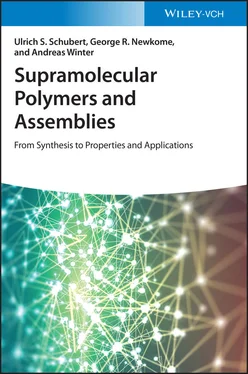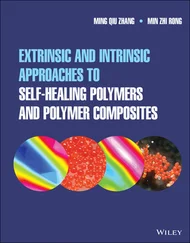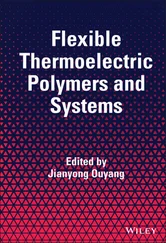3 Chapter 3Figure 3.1 Schematic representation of the various types of architectures accessible via H‐bonding interactions (A: H‐bonding acceptor, D: H‐bonding donor) [3]. Source: Redrawn from Binder and Zirbs [3]. © 2007 Springer Nature. Figure 3.2 (a) Classification of H‐bonds according to Jeffrey and Saenger (D: H‐bonding donor, A: H‐bonding acceptor, M: metal ion). Source: Jeffrey and Saenger [16]. © 1991 Springer Nature.Figure 3.3 Schematic representation of various single H‐bonding motifs.Figure 3.4 Schematic representation of various two‐centered H‐bonding motifs (A: adenine, T: thymine, G: guanine, C: cytosine).Figure 3.5 Schematic representation of various triple H‐bonding motifs (A: adenine, T: thymine, G: guanine, C: cytosine).Figure 3.6 Schematic representation of triple H‐bonding arrays exhibiting different K avalues (D: H‐bonding donor; A: H‐bonding acceptor, K A: association constant in CHCl 3). Source: Brunsveld et al. [5].Figure 3.7 (a) Schematic representation of various quadruple H‐bonding motifs (from left to right). Source: Refs. [18,19] and Prabhakaran et al. [20]Figure 3.8 Schematic representation of Napy‐induced translation of homodimeric into heterodimeric assemblies via quadruple H‐bonding. Two examples according to Corbin and Zimmerman (a) and Chen (b) are shown in [21,37].Figure 3.9 Schematic representation of heterodimers based on sextuple H‐bonding systems. Source: (a) Chang and Hamilton [38] and (b) Yang et al. [41].Figure 3.10 The utilization of single H‐bonding for the formation of main‐chain supramolecular materials (left) and inter‐chain connection polymer blends (right). Source: Redrawn from Binder and Zirbs [3]. © 2007 Springer Nature.Figure 3.11 The formation of supramolecular ladder‐type polymers and networks based on monomers 1and 2. Source: St.Pourcain and Griffin [73].Figure 3.12 Schematic representation of the formation of a supramolecular polymeric network using double H‐bonding interactions of the self‐complementary uradiazole units.Figure 3.13 (a) Schematic representation of the telechelic PDMSs 3as monomers for the supramolecular ring‐chain equilibrium polymerization. (b) FT‐IR spectra of ( 3b) nat two different concentrations ( c = 1.4 and 20 g l −1). (c) Concentration dependence of the reduced specific viscosity of ( 3b) nand the corresponding dibenzyl ester Bn– 3b–Bn (Bn = benzyl, hexane, 25 °C). Source: Abed et al. [4]. Figure reproduced with kind permission. © 2000 American Chemical Society.Figure 3.14 (a) Schematic representation of the chiral two‐centered H‐bonding unit 4with its bicyclo[3.3.1]nonane core. (b) Schematic representation of the structure‐dependent supramolecular self‐assembly of monomers 5and 6.Figure 3.15 (a) Schematic representation of the supramolecular polymer ( 7) n. (b) Schematic representation of the dense 1D packing of 7ain a slipped fashion (the red twisted blocks represent the PBI core, the bay substituents are shown in gray cones with a blue apex and H‐bonding interactions are indicated as green lines). Source: Würthner et al. [101]. Figure reproduced with kind permission. © 2016 American Chemical Society. Figure 3.16 Schematic representation of the formation of parent DPP from its N ‐ t ‐Boc‐protected derivative 8; DPP self‐assembles into linear supramolecular polymer due to double H‐bonding interactions. Figure 3.17 (a) Schematic representation of the N ‐ t ‐Boc‐protected DPP oligomers 9and 10. (b) Schematic representation of the N ‐ t ‐Boc‐protected DPP and PBI dyes 11and 12. Figure 3.18 Schematic representation of the supramolecular polymerization of the homotelechelic monomers 13aand 13binto an alternating copolymer. Source: Fouquey et al. [2].Figure 3.19 Schematic representation of the LC supramolecular polymer 14. Source: Kotera et al. [115].Figure 3.20 (a) Schematic representation of the formation of supramolecular gels based on triple H‐bonding motifs in concert with additional non‐covalent interchain interactions. Representative field‐emission scanning electron microscopy (FE‐SEM) images of the fibers obtained from the dried benzene gels are also shown (left: 15a, right: 15b). (b) Schematic representation of monomer 16used for the supramolecular polymerization with N ‐dodecyl cyanuric acid. Source: Yagai et al. [119]. Figure reproduced with kind permission; © 2005 American Chemical Society. Figure 3.21 Schematic representation of the equilibrium between supramolecular structures of linear tape‐like and cyclic rosette‐like shapes.Figure 3.22 Schematic representation of the supramolecular polymer 17based on triple H‐bonding interactions, supported by π-π stacking hydrophobic interactions and a PBI core. A representative TEM image of the mesoscopic superstructures that were fabricated by evaporation of a methylcyclohexane solutions of 17( c = 5 × 10 −5mol l −1) on a carbon‐Formvar‐coated nickel grid (200 mesh) and subsequent staining with uranyl acetate is also shown. Source: Würthner et al. [130]. Figure reproduced with kind permission; © 1999 Wiley‐VCH.Figure 3.23 (a) Schematic representation of the heteroditopic PBI 18. (b) Schematic representation of the supramolecular polymerization of 18into cylindrical nanostructures. (c) Representative TEM image of the nanocylinders. Source: Sinks et al. [133]. Figure reproduced with kind permission. © 2005 American Chemical Society. Figure 3.24 (a) Scanning tunnelling microscopy (STM) image of the honeycomb structure on a Ag‐layered Si substrate (inset: high‐resolution view of the substrate surface) [134]. (b) STM image of the Lu@C 82‐loaded network on the Au(111) surface (area of 55 × 40 nm 2). Source: Silly et al. [135]. Figure reproduced with kind permission; © 2003 Nature Publishing Group and 2008 The Royal Chemical Society.Figure 3.25 Schematic representation of the stepwise fabrication of a hybrid structure starting from a supramolecular honeycomb PBI–melamine network. Source: Silien et al. [139]. Figure reproduced with kind permission; © 2009 Wiley‐VCH. Figure 3.26 Schematic representation of the supramolecular self‐assembly of 20aand 21into ribbon‐like aggregates. Representatively, a field‐emission SEM image of the aggregates is also shown. Source: Yagai et al. [123]. Figure reproduced with kind permission. © 2007 American Chemical Society. Figure 3.27 Schematic representation of the monomers 22, which self‐assembled into toroids and linear fibrils (a) or, upon mixing, generated a supramolecular helical polymer (b). Source: Aratsu et al. [141]. Figure reproduced with kind permission. © 2020 Springer Nature.Figure 3.28 A chain‐extended supramolecular block‐copolymer based on triple H‐bonding arrays. PIB: poly(iso‐butylene), PEK: poly(etherketone). Source: Binder et al. [146]. Figure reproduced with kind permission. © 2005 Wiley‐VCH.Figure 3.29 Schematic representation of the homotelechelic PPOs 23. The pictures show pure 23a, pure 23b, and an equimolar mixture of both (from left to right). Source: Cortese et al. [148]. Figure reproduced with kind permission. © 2012 American Chemical Society.Figure 3.30 Schematic representation of the reversible self‐assembly of the nucleobase‐functionalized oligo(phenylene‐ethynylene)s 24(A: adenine, T: thymine). The optical micrograph of an annealed film of the polymer ( 24a··· 24b···) nat 130 °C is also shown (100 ×magnification, the inset shows a section with a 500 ×magnification). Source: Figure reproduced with kind permission; © 2003 The Royal Society of Chemistry. Figure 3.31 (a) Schematic representation of the bolaamphiphiles 25(for the structures of adenine [A] and thymine [T], see Figure 3.30). (b–d) Energy‐filtered transmission electron microscopy (EF‐TEM) images of the fibers formed by self‐assembly in 10% ethanolic aqueous solution at 25 °C (b: 25a, c: 25c, d: 1 : 1 ratio of 25band 25c; the scale bar represents always 1 μm). Source: Modified from Shimizu et al. [151]. Figure reproduced with kind permission. © 2001 American Chemical Society.Figure 3.32 A highly flexible material was formed via the self‐assembly of α , ω ‐dinucleobase‐functionalized PTHF (e.g. 26awith two N 4‐(4‐ tert ‐butylbenzoyl)‐cytosine moieties). Source: Modified from Sivakova et al. [152]. Figure reproduced with kind permission. © 2005 American Chemical Society.Figure 3.33 Schematic representation of two important self‐complementary quadruple H‐bonding arrays with high K avalues. Figure 3.34 (a) Schematic representation of the UPy‐functionalized homotelechelic monomers 27. (b) Representation of the critical concentrations of 20in supramolecular ring‐chain equilibrium polymerizations. Source: ten Cate and Sijbesma [11]. Figure reproduced with kind permission. © 2003 Wiley‐VCH.Figure 3.35 Schematic representation of the UPy‐functionalized homotelechelic monomers 29– 31.Figure 3.36 Images of a bis ‐UPy‐functionalized poly( ɛ ‐caprolactam) that was processed into different scaffolds: (a) thin films, (b) fibers, (c) meshes (a representative SEM image is depicted), and (d) grids. Source: Dankers et al. [165]. Figure reproduced with kind permission. © 2005 Nature Publishing Group. Figure 3.37 Schematic representation of the fabrication of vascular graft from UPy‐equipped macromolecular components. The pictures show the results of the in‐vivo cell‐adhesion experiments. Source: van Alme et al. [166]. Figure reproduced with kind permission. © 2016 Wiley‐VCH.Figure 3.38 (a) Schematic representation of the H‐bonded dimer 32. (b) SEM image of the surface roughness (scale bar: 2 μm). (c) Representation of the superhydrophobicity of the resulting surface: Water contact angle of c. 150°. Source: Han et al. [175]. Figure reproduced with kind permission. © 2004 American Chemical Society.Figure 3.39 Schematic representation of the formation of supramolecular AB‐type diblock copolymers due to complementary H‐bonding interactions. Source: Feldman et al. [178]. © 2008 American Chemical Society.Figure 3.40 Schematic representation of the UPy‐ and Napy‐functionalized homopolymers 33and 34. The microscopy images show the microstructure of the blends after annealing at various temperatures. Source: Modified from [178]. Figure reproduced with kind permission. © 2008 American Chemical Society.Figure 3.41 Schematic representation of the supramolecular diblock copolymers 35and 36. A representative TEM image of 35showing the microphase separation in the solid state is also shown. Source: Rao et al. [186]. Figure reproduced with kind permission. © 2012 The Royal Chemical Society.Figure 3.42 Schematic representation of the formation of a strictly alternating supramolecular copolymer using the non‐self‐complementary monomers 37and 38. Source: Based on Park and Zimmerman [187]. © 2006 American Chemical Society.Figure 3.43 Schematic representation of the heteroditopic H‐bonding units 39– 41.Figure 3.44 Schematic representation of the photoreversible formation of the supramolecular polymer ( c ‐ 42) n.Figure 3.45 (a) Schematic representation of the various bis‐UPy‐functionalized π‐conjugated chromophores 43– 45. (b) Schematic representation of the proposed energy‐transfer process within the supramolecular copolymers. (c) Representation of the emission colors of the three individual homopolymers and the three‐component copolymer in solution (top) as well as in the solid state (bottom). Source: Abbel et al. [195]. Figure reproduced with kind permission. © 2009 American Chemical Society.Figure 3.46 Schematic representation of the quadruple H‐bonding arrays 46and 47based on self‐complementary 1,3,5‐triamino‐2,4,6‐triazine derivatives (R denotes aliphatic and oligo(ethylene glycol) chains – chiral and non‐chiral ones).Figure 3.47 (a, b) Schematic representation of the self‐assembly of the heterodifunctional H‐bonding array 48into a supramolecular polymer. (c) Temperature‐dependent UV/vis absorption spectra of 48(0.10 mM in decaline); the inset shows the evolution of the absorbance at 349 nm when the temperature was changed. Source: Ikeda et al. [197]. Figure reproduced with kind permission. © 2005 Wiley‐VCH.Figure 3.48 (a) Schematic representation of the linear supramolecular polymer 49. (b) Representative electron‐microscopy images of the extended, densely packed fiber networks obtained from the solution of 49(2.5 mmol l −1in CHCl 3/heptane, 1 : 4 ratio). Source: Berl et al. [198]. Figure reproduced with kind permission. © 2002 Wiley‐VCH.Figure 3.49 Schematic representation of the formation of homopolymers and diblock copolymers equipped with Hamiltonian receptors or barbiturate units. PS: polystyrene, PMMA: poly(methyl methacrylate), PLMA: poly(lauryl methacrylate), P n BuA: poly( n ‐butyl acrylate). These macromonomers were assembled into supramolecular pseudo‐block copolymers via sextuple H‐bonding interactions. Source: Chen et al. [201]. Figure reproduced with kind permission. © 2012 The Royal Chemical Society. Figure 3.50 Schematic representation of the formation of a supramolecular helix–helix diblock copolymer. Source: Croom et al. [204]. Figure reproduced with kind permission. © 2016 American Chemical Society.Figure 3.51 Schematic representation of the heterotelechelic polymer 50that showed a concentration‐dependent self‐assembly behavior (i.e. formation of single‐chain macrocycles vs. chain‐extended polymers). Source: Altintas et al. [206]. Figure reproduced with kind permission. © 2010 The Royal Chemical Society.Figure 3.52 Schematic representation of Lehn's concept of double dynamic supramolecular polymers (“double dynamers ”). Source: Kolomiets et al. [209]. © 2005 The Royal Chemical Society.Figure 3.53 Schematic representation of the directed self‐assembly of the calix[4]arenes 51and 52into columnar structures via tris‐aminotriazine/barbiturate interactions. Source: Klok et al. [211]. Figure reproduced with kind permission. © 1999 American Chemical Society.Figure 3.54 Schematic representation of the supramolecular diblock copolymer 53featuring a sextuple H‐bonding linkage (PS block: M n= 20 000 g mol −1, PEG block: M n= 5000 g mol −1). A representative AFM image of a spin‐coated thin film is also depicted. Source: Yang et al. [41]. Figure reproduced with kind permission. © 2004 Wiley‐VCH.Figure 3.55 (a) Schematic representation of the cyclic eight‐residue peptide 54and of its self‐assembly into supramolecular nanotubes. (b) b1: TEM image of the supramolecular nanotubes adsorbed onto a carbon support film; b2: Low‐dose cryo‐microscopy image of a single nanotube. (c) Schematic representation of the cyclic four‐residue peptide 55. Source: Khazanovich et al. [217]. Figure reproduced with kind permission. © 1994 American Chemical Society.Figure 3.56 (a) Schematic representation of the formation of a “supramolecular rubber,” based on multiple H‐bonding. (b) Representation of a polymer network formed by mixtures of ditopic (blue) and tritopic (red) building blocks, self‐assembled by directional interactions (dotted lines). (c) Stress–strain curve of the supramolecular rubber. Source: Cordier et al. [230]. Figure reproduced with kind permission. © 2008 Springer Nature.
Читать дальше












